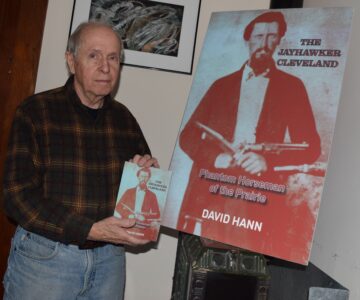Lawrence writer’s novel revives interest in ‘Jayhawker Cleveland’; ‘It’s a story that should become a touchstone in early Kansas history’

photo by: Chansi Long
Author David Hann stands in his Lawrence home next to a blown-up photo of the cover of "The Jayhawker Cleveland: Phantom Horseman of the Prairie," Hann's new novel. The cover features a picture of Marshall Cleveland, the novel's protagonist, holding two revolvers and a Bowie knife in 1861.
Before COVID, David Hann, of Lawrence, would occasionally spend hours at the Kansas State Historical Society in Topeka poring over microfiche archives in search of interesting people, places and events. A former administrator at the University of Kansas, now a writer, Hann wasn’t looking for writing material; he was just entertaining himself as a history buff.
One day Hann discovered the story of a man named Marshall Cleveland. Propelled from article to article, Hann became convinced that he was unearthing a story of a man who never should have been forgotten.
“Research revealed a most interesting and unique character,” Hann says. “As one newspaper put it, (‘Cleveland’s) story would be told around the fireside for a hundred years. Of course, the newspaper was wrong and his story has been forgotten.”
According to Hann’s account, Cleveland — who had the aliases Kingman Moore and Charles Metz — was a liberator of slaves and horses during the 1861-1862 period of the Kansas-Missouri Border War. Hann’s book follows Cleveland from New York’s 1849 cholera epidemic to Ohio, where he drives a stagecoach, then guides a group of Free State settlers bound for Kansas into Missouri. Early on in the narrative, Cleveland is imprisoned for abolitionist activity in Ohio.
“The judge connected Cleveland with (a group called) the Rescuers, who attacked (an) Ohio sheriff who had imprisoned escaped slaves,” Hann says. “It’s notable, at least to me, that the judge convicted (Cleveland) on the basis of what the judge thought he would do in Missouri — not for what he had done.”
Hann then reconstructs Metz’s experience in the Missouri Penitentiary, from which he escapes. Metz changes his name to Kingman Moore and journeys to Kansas via riverboat on the Missouri River. Then he changes his name to Marshall Cleveland, joins Jennison’s Jayhawkers in Kansas and fights against slavery.
Local writer Melvin Litton says Hann’s resulting novel, titled “The Jayhawker Cleveland: Phantom Horseman of the Prairie,” rockets the reader from chapter to chapter — much in the same way Hann was propelled by the news articles that inspired him.
“David Hann is a storyteller … full of grit and determination and utterly void of cynicism, traits once common to the American spirit that I find so refreshing,” Litton says. “I found his narrative engagingly swift and succinct.(It) grabs you from the first page and rides you to the very end.”
Hann says one of the biggest difficulties in writing the book was the fact that he initially didn’t realize that’s what he wanted to do.
“I wasn’t thinking of writing a book,” Hann says. “(I was) just wanting to find out more information about this interesting character from the Kansas-Missouri Border War era. I often failed to note the newspaper and date where and when certain events occurred.”
Hann found stringing the vignettes culled from 1860s news archives into a coherent narrative challenging.
“A big help to me later on was the discovery of Newspapers.com, with its search facility,” Hann says. “(It was) much easier than trying to read and copy microfiche from 1860s newspapers. Also, restrictions on doing research at KSHS due to COVID hampered me, but Newspapers.com greatly helped me overcome that obstacle.”
Despite the challenges, Hann was compelled to persevere with his novel by Cleveland’s quirky character. Hann found odd details about Cleveland amusing, like how he would refrain from killing his enemies. One time Cleveland disarmed a cavalry unit intent on apprehending him, yet returned their horses and weapons and let them flee. Another time Cleveland snatched weapons from a Missouri Guard unit, freed their slaves and instructed them to tell their commander to make sure future military members knew how to use their weapons when they came to Kansas.
Brian Daldorph, a Lawrence writer who also teaches creative writing at KU, was intrigued by Cleveland as a character and by Hann’s storytelling skills.
“Hann’s story of the life journey of Cleveland from his birthplace in New Jersey during the cholera epidemic, to Ohio, then to Kansas, is a wild ride indeed,” Daldorph says. “There are some brilliant scenes in the book which stay with me. In 1861, two young soldiers on Shawnee Street in Leavenworth, Kansas, pass a Wanted: Dead or Alive poster (featuring) Marshall Cleveland, a Jayhawker at war with the Missouri Bushwhackers. Then they see a tall handsome horseman riding towards them, proud and fearless: Cleveland, very much alive.”
Litton believes the book should revive interest in Cleveland, providing not just entertainment, but historical enrichment.
“(This) is a name and figure all but lost to history until David retrieved him from the dust for our reading pleasure,” Litton says. “It’s a story that should become a touchstone in early Kansas history and find a place on bookshelves in homes, libraries and schools, enjoyed by readers from eighth graders to those in their 80s.”







